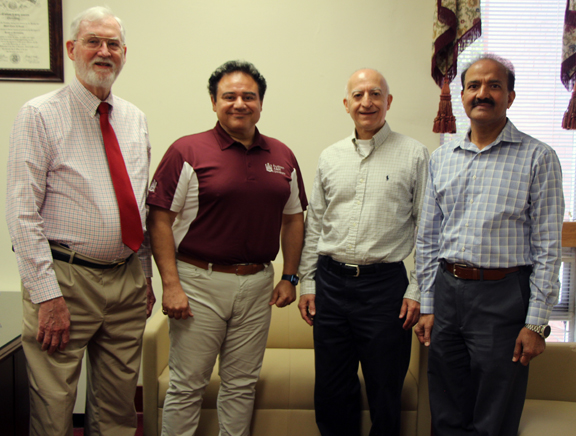AAMU Artificial Intelligence Lab Gets Boost from Army

The Utter Realness of A.I.
The College of Engineering, Technology and Physical Sciences (CETPS) at Alabama A&M University has received yet another financial boost of confidence in its two-year-old Laboratory for Deep Learning (LDL) from the Army Research Office (ARO).
If artificial intelligence (AI) is the wave of the future, then it's cowabunga for a team of electrical engineering professors, who work consistently to ensure that AAMU students receive the best equipment for hands-on learning. The top-notch equipment made possible by an additional ARO award of $384,605 will enable students and researchers to keep cranking out new insights.
Back in 2020, Dr. Kaveh Heidary and Dr. R. Barry Johnson set up the Laboratory for Deep Learning to enhance the engineering college’s capabilities in the vast realm of artificial intelligence and machine learning. A prior ARO award of over $100,000 was utilized to purchase a hyperspectral camera that covered the visible spectrum and was the initial equipment in the LDL. Keeping up to par entailed building up pseudo visual perception capabilities and readying a lab to delve super-deep into the intricacies of how humans gain and use knowledge from imagery.
A year later, ARO awarded the duo’s lab the first award of $206,782 to purchase a much-needed high-performance data processing and computing platform and a special hyperspectral camera capable of taking pictures in 165 color bands at the same time!
 In addition, equipment is being purchased to provide the capability for faculty and
students to design and fabricate Field Programmable Gate Array (FPGA) devices that
enable the development of custom logic for rapid prototyping. FPGAs are perfectly
suited for today’s rapidly growing applications, such as custom computing, artificial
intelligence, system security, 5G, factory automation, and robotics. This year, the
lab received its second ARO award, and Dr. Raziq Yaqub joined the team.
In addition, equipment is being purchased to provide the capability for faculty and
students to design and fabricate Field Programmable Gate Array (FPGA) devices that
enable the development of custom logic for rapid prototyping. FPGAs are perfectly
suited for today’s rapidly growing applications, such as custom computing, artificial
intelligence, system security, 5G, factory automation, and robotics. This year, the
lab received its second ARO award, and Dr. Raziq Yaqub joined the team.
Now, those needed visual perception capabilities, which AI and machine learning often sorely depend on, have been brought to fruition. A suite of high-performance, high-definition cameras covering the ultraviolet (UV) to the long-wave infrared (LWIR) have been purchased, along with gimbals and an industrial-grade drone to transport them. The ability to fly this suite of cameras will provide AAMU with a unique capability that already government and industry desire to utilize to create databases of imagery of a wide variety of things.
Heidary and his team realized early on that AI and machine learning (ML) research was postured for growing importance in such areas as health care, automobile manufacturing, agriculture, spacecraft systems, border control, and national security. Having quality imagery from the UV to the LWIR often is necessary to implement AI and ML in products and systems. Creating such imagery is a goal of the Laboratory for Deep Learning, and the investment of over $700,000 by the Army Research Office has, in part, made the LDL a reality.
“This one-of-a-kind laboratory will enable faculty to develop new education and research programs in imaging, autonomy, data science, and deep learning,” explained Dr. Heidary. The clincher, though, is the lab’s increasing ability to attract and educate students in programs of “strategic importance to our nation’s economic and technological advantage and military preparedness.”
In addition to improving AAMU’s STEM pipeline, CETPS can further thrust into the limelight its newly established M.S. program in electrical engineering (MSEE), as well as equip researchers with the tools needed to pursue additional competitive research funding.
For additional information about the ARO grant and AAMU’s AI capabilities, contact Dr. Kaveh Heidary, the Principal Investigator, at (256) 372-5587 or e-mail kaveh.heidary@aamu.edu.
Copy and Photos by J. Saintjones
CAPTION: (l-r): Dr. R. Barry Johnson; Dr. Majed Dweik, AAMU VP for Research and Economic Development; Dr. Kaveh Heidary, P.I.; and Dr. Raziq Yaqub.